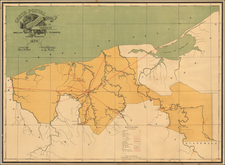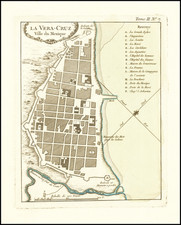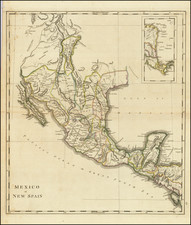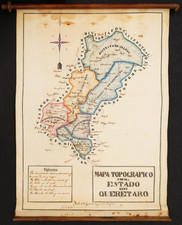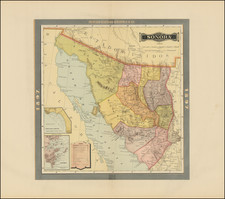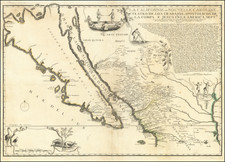Painted Map of Mexico by Noted American Female Artist
Made While Studying Under Famed Mexican Muralist David Alfaro Siqueiros
A beautiful and detailed painted map of Mexico, the work of noted American artist and art educator Mary A. Reardon, who is best known as the designer and painter of the "first true fresco in the United States."
The map was painted in 1949, likely during Reardon's time in San Miguel de Allende, where she was studying mural painting and fresco technique under David A. Siqueiros, one of the big three of Mexican muralism, along with Diego Rivera and Jose Clemente Orozco. Reardon is mentioned in Siqueiros's book, How to Paint a Mural, as being one of his art students, along with several American war veterans, who collaborated with him on a mural in San Miguel de Allende, titled Vida y Obra de General Ignacio Allende. The mural, which was painted in an old convent building, was never completed.
Mary Agnes Reardon (1912-2002) was born in Quincy, Massachusetts. A painter, art educator, and illustrator of children's books, she is perhaps best known for her mural work in Catholic churches. Reardon received an AB degree from Harvard (Radcliffe College) in 1934, and a Bachelor of Fine Arts degree from Yale in 1939. In 1948-49 she traveled to Mexico to learn mural painting techniques, including the true fesco, from David Siqueiros. Reardon was associate professor at Emmanuel College, Boston, 1952-1972 and also taught art workshops at the Boston Museum of Fine Arts.
Fusing Mexican Mural Style with Pictorial Map-making
The present Mexico map, which shows the country's regions and states, was painted during or soon after Reardon's collaboration with Siqueiros, likely while she was still in San Miguel de Allende. The painting exhibits her developing muralistic style through a personal interpretation of Mexican culture. It is particularly notable as a dynamic fusion of the mural style and popular pictorial map-making. The painting's border incorporates decorative elements evocative of Mexican murals, including Mayan glyphs, an Aztec calendar, and a Mexican flag. Illustrations on the map itself include a Chihuahua dog, various regional costumes including a Tehuana woman, a bull fighter, a cathedral, and several others. While the southern U.S. is partially shown on the map, only a single pictorial element on the U.S. side is included: the Alamo in San Antonio.
Reardon's noted liturgical murals include a triptych at Cathedral of Mary Our Queen (Baltimore), mosaic murals at St. Mary's Cathedral (San Francisco), and mosaic dome walls in St. Louis Cathedral. She also designed and painted the "first true fresco in the United States" at St. John Seminary in Brighton, Massachusetts.
Collections of Reardon's papers and works are preserved in the Smithsonian Archives of American Art, Emmanuel College, and Massachusetts Historical Society.
Mary Agnes Reardon (1912–2002) was an influential Catholic liturgical artist known for her work as a painter, muralist, designer, and illustrator of children's books.
Educated at Radcliffe College and the Yale School of Fine Arts, Reardon graduated with a Bachelor of Fine Arts in 1939. Further honing her skills in Mexico under the guidance of David Alfaro Siqueiros, Reardon mastered the technique of true fresco, leading to her creation of the United States' first true fresco at St. John Seminary in Brighton, Massachusetts.
Her artistic contributions include significant works in various religious settings. Notably, she designed and painted the Guadalupe chapel and two transept ceilings at the National Shrine of the Immaculate Conception in Washington, D.C., and a triptych at the Cathedral of Mary our Queen in Baltimore, Maryland. Her early mural at Cabot Hall, Radcliffe College, and the decorative elements at the St. Louis Cathedral further showcase her versatility and commitment to integrating art with faith.
Reardon also illustrated seven children's books, with "Snow Treasure," written by Marie McSwigan, being among the most celebrated. This book, found in over 1,400 libraries as of 2015, highlights her ability to engage young readers through visual storytelling. Mary Agnes Reardon's legacy is marked by her significant contributions to both liturgical art and children's literature, reflecting her deep faith and artistic skill. Her work continues to be appreciated for its beauty and spiritual depth.
Collections of Reardon's papers and works are preserved in the Smithsonian Archives of American Art, Emmanuel College, and Massachusetts Historical Society.









